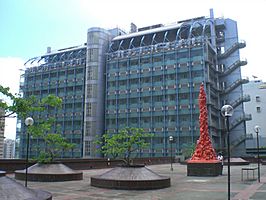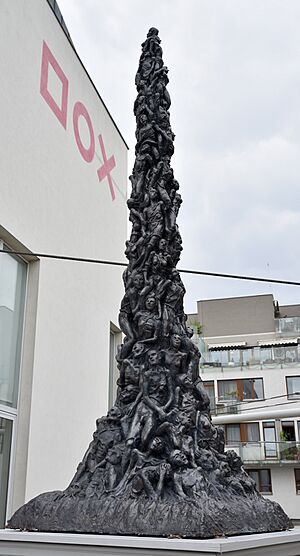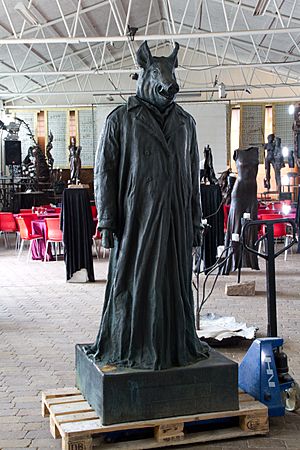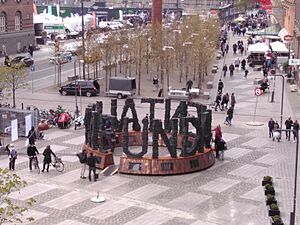Jens Galschiøt facts for kids
Quick facts for kids
Jens Galschiøt
|
|
|---|---|
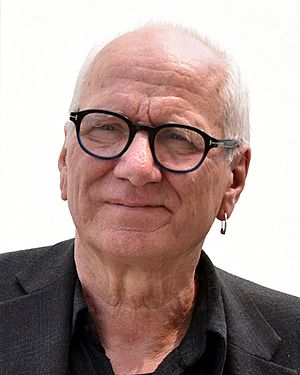
Jens Galschiøt in 2022
|
|
| Born | 4 June 1954 Frederikssund, Denmark
|
| Nationality | Danish |
| Known for | Sculpture |
|
Notable work
|
Pillar of Shame series |
Jens Galschiøt (born June 4, 1954) is a famous Danish artist who makes sculptures. He is best known for his powerful sculpture series called the Pillar of Shame. His art often carries a strong message about problems in the world.
Galschiøt moved to the city of Odense in 1973. In 1985, he opened a large workshop that is a studio, a metal foundry (a place to melt and shape metal), and a sculpture park all in one. He creates many different kinds of art, including installation art, where the artwork is a whole environment, and Street Art, which he places in public spaces for everyone to see.
He often uses his own money to create large bronze sculptures. He then places them in major cities around the globe to make people think about injustice and human rights.
Contents
The Pillar of Shame
The Pillar of Shame is one of Galschiøt's most famous projects. It is a series of sculptures that act as memorials for terrible events. Each pillar is a tall, dark statue made of twisted human bodies, showing pain and sorrow.
Hong Kong
The first Pillar of Shame was placed in Hong Kong in 1997. It was set up to remember the people who died during the Tiananmen Square protests of 1989 in China. The eight-meter-high sculpture was a powerful symbol of this sad event.
In 2008, activists painted the pillar orange. This was part of a campaign Galschiøt started called The Color Orange, which aimed to draw attention to human rights issues in China before the Beijing Olympic Games. Galschiøt tried to travel to Hong Kong to help but was not allowed into the country.
Mexico
In 1999, a second Pillar of Shame was put up in Mexico City. It was a protest against the unfair treatment of the native, or indigenous, people in the country.
Later, the sculpture was moved to the village of Acteal. This was to remember 45 unarmed indigenous people who were killed there in 1997. The pillar stands as a permanent reminder of this tragedy.
Brazil
A third Pillar of Shame was erected in Brasília, the capital of Brazil, in 2000. It honored 19 landless farm workers who were killed by police during a protest in 1996.
There was a lot of disagreement about setting up the sculpture, but it was eventually placed in the city of Belém. The city's mayor said the pillar was a symbol against violence and for people's rights.
Prague
On June 4, 2022, another Pillar of Shame was installed in a modern art museum in Prague, the capital of the Czech Republic. This was done on the 33rd anniversary of the Tiananmen Square event to continue raising awareness.
Other Famous Sculptures
Jens Galschiøt has created many other thought-provoking sculptures and art projects. He often places them in public areas, sometimes as a surprise, to get people talking.
My Inner Beast
In 1993, Galschiøt created a project called My Inner Beast. He made twenty heavy, black concrete sculptures of a pig wearing human clothes. In just 55 hours, he and his team placed these statues in twenty different cities across Europe without permission.
The goal was to make people think about the rise of intolerance and racism. The surprise statues caused a lot of discussion. Today, some cities have given the sculptures a permanent home. For example, you can find a "Beast" in Copenhagen, Milan, and Barcelona.
The Children of Abraham
This project is about the three major religions that trace their roots to Abraham: Judaism, Christianity, and Islam. The main part of the project is a giant sculpture called Fundamentalism.
The sculpture spells out the word "FUNDAMENTALISM" with huge letters. These letters are covered in 600 quotes from the holy books of the three religions: the Torah, the Bible, and the Quran. The artwork encourages people from different faiths to talk to each other and find common ground.
Survival of the Fattest
This is a 3-meter-high bronze sculpture of a very large woman sitting on the shoulders of a thin, tired-looking man. The woman represents Justitia, the figure of justice, but she is holding scales that are unbalanced.
The man represents the poor countries of the world, who are carrying the burden of the richer countries. The sculpture is a comment on the unfair economic relationship between rich and poor nations.
The Hunger March
The Hunger March is an installation of 27 life-sized bronze sculptures of starving young boys. These sad figures have been part of many protests and events around the world. They are a powerful reminder of global hunger and poverty.
Galschiøt's Workshop and Gallery
In the city of Odense, Galschiøt has a large workshop and gallery that is open to the public for free. The 10,000-square-meter space was once a car factory. Today, it is a creative center where art is made and displayed.
Visitors can see many of Galschiøt's sculptures and other artworks. The building also has a concert hall, an art school, and a shop where you can buy smaller sculptures and jewelry made in the workshop. It is one of the few places in Denmark where artists can learn the craft of casting metal.
See also
 In Spanish: Jens Galschiot para niños
In Spanish: Jens Galschiot para niños
- Art of Denmark
- My Inner Beast
- The Color Orange
- Pillar of Shame
- Fundamentalism
- The Hunger March
- In the Name of God
- Survival of the Fattest
- SevenMeters
- Odense


